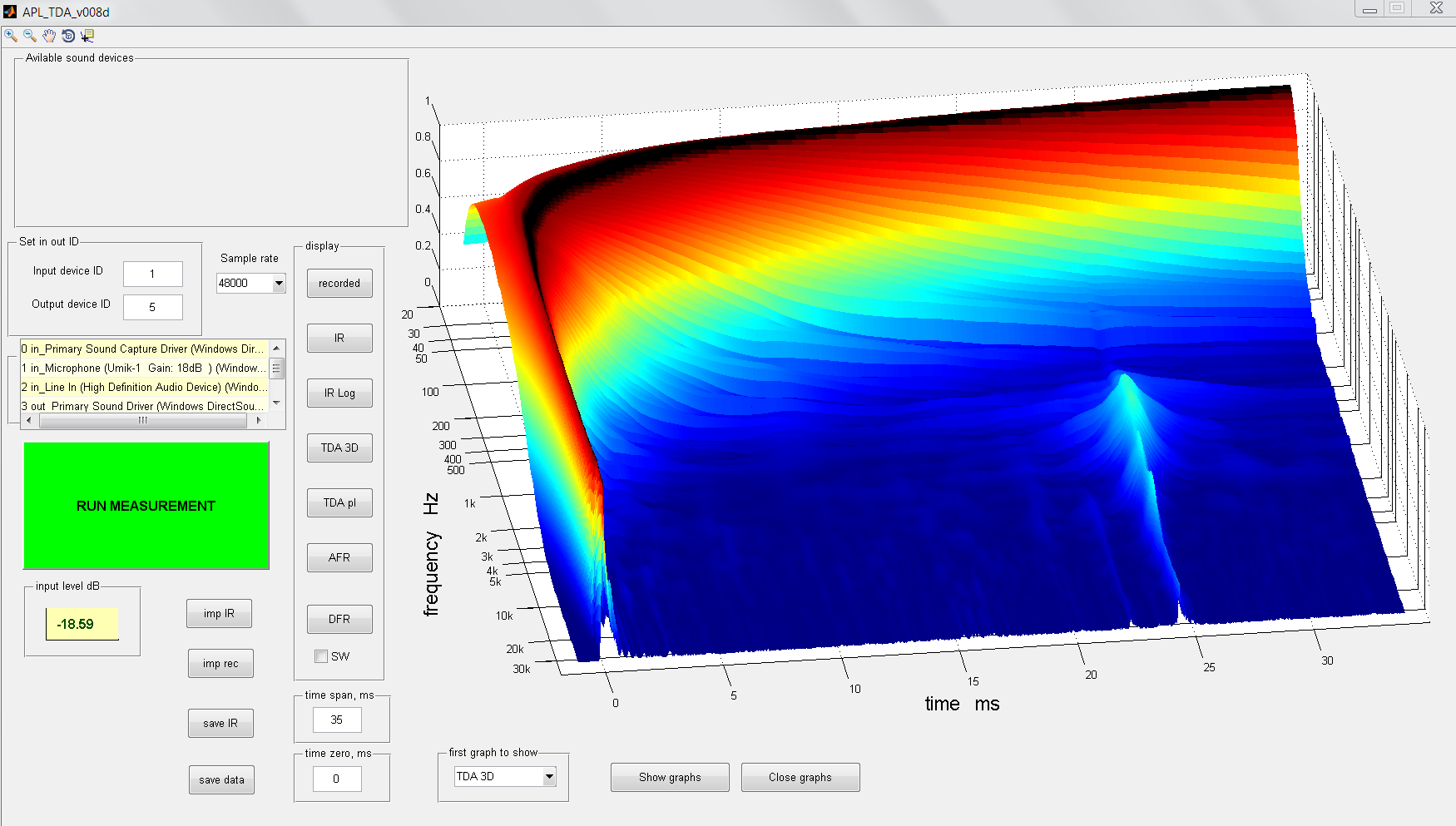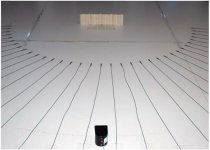I recently picked up 12 Auralex T'Fusor panels.
My room is 14.5 wide by 23 deep and my horns are pretty much butted up against the side walls firing down the long end of the room. The primary listening area is six feet out from the back wall. The system has pretty much controlled directivity down to 200 Hz and is mostly around 60-80 degree radiation.
Where do you recommend I start experimenting with placement of these panels?
I'm thinking of using a few of them behind me on the back wall.
Auralex Acoustics | T’Fusor? 3D Sound Diffusor
Thanks
My room is 14.5 wide by 23 deep and my horns are pretty much butted up against the side walls firing down the long end of the room. The primary listening area is six feet out from the back wall. The system has pretty much controlled directivity down to 200 Hz and is mostly around 60-80 degree radiation.
Where do you recommend I start experimenting with placement of these panels?
I'm thinking of using a few of them behind me on the back wall.
Auralex Acoustics | T’Fusor? 3D Sound Diffusor
Thanks
Not easy to suggest blind. I think the reverberant field should be diffuse. On one hand the speakers should be initially contributing to that. If there is a problem with the near walls that might seem like a good place to diffuse but it's debatable that this should be happening in the first place so the rear wall seems the safe place. I've seen them in the first half of the room but they would have to fit in with your early reflection goals. I would be considering their working range and decide what places want diffusion and what places want absorption.
If your speakers are very directional and pointed a little inward toward you, try putting the diffusors behind you and to the sides a little so that they catch the waves that fly past you and reflect it (delayed and diffused) back at you. I have that arrangement and it works well for me. Tried them on sides and in front between the speakers, but those didn't work as well (though maybe looked a little better!)
Thank you both.
bwaslo- are you saying catching the waves on the adjacent side wall behind me from the horn radiating from the opposite wall? That sounds like it might open things up. 😉 I will try this this weekend.
bwaslo- are you saying catching the waves on the adjacent side wall behind me from the horn radiating from the opposite wall? That sounds like it might open things up. 😉 I will try this this weekend.
Yup. But try to get the delay as long as you can get it (move the diffusors as far back as possible)
Not sure if it was placebo, but I seam to hear "problems" when placed behind and to the side of the head. But i am very close to the back wall so the diffusors are close
Scattered on the front wall (behind speakers and in centre) works well for me particularly where the upper bass and low mids spread around to the back and reflect directly off the panels. I spread the panels and sit them a foot forward of the wall to try to diffuse some of the bass frequencies as well
The first reflections from the floor works too but it is impractical
Scattered on the front wall (behind speakers and in centre) works well for me particularly where the upper bass and low mids spread around to the back and reflect directly off the panels. I spread the panels and sit them a foot forward of the wall to try to diffuse some of the bass frequencies as well
The first reflections from the floor works too but it is impractical
Last edited:
POOH, this might be a good idea if you have the space:

Source: https://www.gearslutz.com/board/studio-building-acoustics/817205-my-listening-room.html
Jim set it up like that to control the timing of it as a true Haas kicker. By bouncing it off a second panel the diffused sound arrives as late like it would in a bigger room. He has it timed at ~24 ms after the mains:

(as measured with the Demo version of APL_TDA software... You see the Haas kicker firing at 24 ms.

Source: https://www.gearslutz.com/board/studio-building-acoustics/817205-my-listening-room.html
Jim set it up like that to control the timing of it as a true Haas kicker. By bouncing it off a second panel the diffused sound arrives as late like it would in a bigger room. He has it timed at ~24 ms after the mains:

(as measured with the Demo version of APL_TDA software... You see the Haas kicker firing at 24 ms.
Very interesting. Will have to read through that thread. Not sure how he was able to focus the reverb so tightly around 25ms...
Last edited by a moderator:
Your products are probably more scattering units than proper diffusors. And they aren't deep enough to cover much freq. area.
Generally though, diffusion works best where you have late arrival reflections.
Generally though, diffusion works best where you have late arrival reflections.
+1 for behind and especially to the sides. I find the sides adds detail and helps me catch stuff that I would miss, meaning, it helps fill in between the speakers with music that I would otherwise not hear.
Last edited:
thanks for all the help guys. i'm finally playing around with these diffusors and so far they seem to be doing a great job with the system.
QUESTION
is there an easy to use program out there that uses some science to place the diffusors perfectly in relationship to me, the speakers and the room boundaries
QUESTION
is there an easy to use program out there that uses some science to place the diffusors perfectly in relationship to me, the speakers and the room boundaries
Considering this is dependent on what acoustic principle one is following, the type of diffusor as well as several other aspects; the answer to that would be no.QUESTION
is there an easy to use program out there that uses some science to place the diffusors perfectly in relationship to me, the speakers and the room boundaries
Considering this is dependent on what acoustic principle one is following, the type of diffusor as well as several other aspects; the answer to that would be no.
Thanks, a program where you could input that data in and get a diagram would be sweet.
earlier you commented where these diffusors may scatter more than diffuse. can you explain that more
Auralex Acoustics | T’Fusor? 3D Sound Diffusor
One simply needs to learn psycoacoustics, the performance of the diffusor and measure adequately in the specific setup.Thanks, a program where you could input that data in and get a diagram would be sweet.
There's a difference between scattering and diffusion. Scattering simply implies that the energy is distributed in a non-specular direction, but the energy isn't evenly distributed and will focus certain frequencies in certain direction.earlier you commented where these diffusors may scatter more than diffuse. can you explain that more
Auralex Acoustics | T’Fusor? 3D Sound Diffusor
Diffusion on the other hand is a uniform distribution of the energy, which which will color the sound far less.
There really should be measurements of both and a diffusor shouldn't be measured alone but with several units together. Like what you see in the picture below.
A product like the T’Fusor with a surface that changes with wells in different directions is very unlikely to offer any proper diffusion. Also, the depth of the wells in the diffusor will imply how low in frequency the diffusor operates. Shallow products, like this one, is incapable of offering scattering or diffusion low in frequency. Thus it will be very bandlimited, hence change the spectral content to a greater degree.
Attachments
So if I use insulation (like the manufacture recommends)on the back of these T'Fusors I should expect what? I'm thinking it would absorb the midrange but otherwise have little effect on the scattering?
I enjoy your website. There is a lot to learn. Browsing through I found the mid bass horns. Those should be fantastic 🙂

Nyheter | Lyd & Akustikk

Nyheter | Lyd & Akustikk
Hi Pooh, not answering your question directly, but a good starting point for an acoustically balanced listening room is to shoot for an even RT across the frequency range. For small room, I'm using the RT30 in rew, but honestly the absolute measure is not as critical as the relative measure. Shoot for an even RT, be it 0.2s (very tight and lean) or 0.4s (more live) sound, it gives a measurable baseline for diffuser placement. Then you can tweak from there.thanks for all the help guys. i'm finally playing around with these diffusors and so far they seem to be doing a great job with the system.
QUESTION
is there an easy to use program out there that uses some science to place the diffusors perfectly in relationship to me, the speakers and the room boundaries
This is my experience, not sure if it's the best way but it sure works for me.
Cheers!
Sent from my X9009 using Tapatalk
Depends on type of insulation, size, thickness and how much goes around the T'Fusors. It becomes a rather complex behavior which is difficult to predict accurately. Generally though; thick porous of low density behind will absorb mids and lows.So if I use insulation (like the manufacture recommends)on the back of these T'Fusors I should expect what? I'm thinking it would absorb the midrange but otherwise have little effect on the scattering?
You're right, it will not effect the scattering in front.
RTx measurements are not valid in small rooms. This is unfortunately one of the myths that still lives, but it has been proven many years ago that it's invalid measurement for small rooms. Reverberation time only exists where there's a diffuse sound field, which is only the case in very large rooms.Hi Pooh, not answering your question directly, but a good starting point for an acoustically balanced listening room is to shoot for an even RT across the frequency range. For small room, I'm using the RT30 in rew, but honestly the absolute measure is not as critical as the relative measure. Shoot for an even RT, be it 0.2s (very tight and lean) or 0.4s (more live) sound, it gives a measurable baseline for diffuser placement. Then you can tweak from there.
This is my experience, not sure if it's the best way but it sure works for me.
Cheers!
Sent from my X9009 using Tapatalk
What we have in a small room is specular reflections (besides room modes) and this needs to be treated according to the desired acoustic principle by using ETC graphs and with an understanding of broadband treatment.
Following your advice for treatment in a small room would often yield a poor result with bandlimited treatment that alters the spectral content to a great degree, and without treating specular reflections arriving at the listening position well. There are much better ways.
- Status
- Not open for further replies.
- Home
- Loudspeakers
- Multi-Way
- Placement of Diffusors
